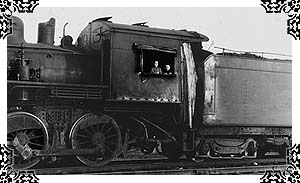








 Up
until 1950, the engines on the P.E.I. Railway functioned
by steam. Each engine contained a coal-burning furnace,
which heated the water contained in a large boiler to
produce the steam. The accumulated pressure from the
expanding vapor was what drove the pistons of the engine,
enabling the train to move forward.
Up
until 1950, the engines on the P.E.I. Railway functioned
by steam. Each engine contained a coal-burning furnace,
which heated the water contained in a large boiler to
produce the steam. The accumulated pressure from the
expanding vapor was what drove the pistons of the engine,
enabling the train to move forward.
In the steam engine, it was the duty of the fireman to keep a bright and even fire roaring, and to ensure that the water level in the boiler was at the exact level needed to maintain speed across different types of terrain, such as flat beds, hills, and curves. A bad fire could result in either low water or low steam levels, and eventually, ended in unscheduled stops and slow running times.
Learning how to properly 'fire' a steam engine was a real art. It was hard enough even standing on the sliding cab of the train; maintaining an even fire and taking accurate readings of the water glass under these conditions took an immense amount of skill. Also, a fireman would have to travel a stretch of track until he knew its ups and downs, levels and curves, like the back of his hand. Looking out the left side of the train, he would develop a set of landmarks that told him his exact location and allowed him to adjust steam pressure accordingly.
 Expert
firemen frequently advanced up the ladder and became
drivers, where they would have to relearn their territory
from a new vantage point. A first-run driver could not
use the signposts familiar to him as a fireman, since he
could now only see out of the right side of the train.
Fortunately, most new drivers were placed with a seasoned
fireman, who could provide guidance along the route and
ease any problems encountered. However, there were
occasions when a new driver was teamed with a new
fireman, and this invariably made for an interesting run.
One such situation arose on the Island in the 1940's when
Eddy Doyle and Bill Brennan were scheduled to make their
first run together out of Emerald Junction, with Doyle as
driver and Brennan as fireman. Their train went missing
for hours, prompting the dispatcher to call from Borden
to ask if some kind of accident had occurred. The train
eventually straggled into Borden so late that it had to
be laid up there overnight. Doyle and Brennan, of course,
were the recipients of a considerable amount of ribbing
from their co-workers, one of whom suggested that--
instead of wearing a watch to time their trips-- the two
men could keep track on a calendar. However, this school
of hard knocks definitely did not injure the careers of
Doyle and Brennan, who became over the years one of the
most respected railway teams on the Island.
Expert
firemen frequently advanced up the ladder and became
drivers, where they would have to relearn their territory
from a new vantage point. A first-run driver could not
use the signposts familiar to him as a fireman, since he
could now only see out of the right side of the train.
Fortunately, most new drivers were placed with a seasoned
fireman, who could provide guidance along the route and
ease any problems encountered. However, there were
occasions when a new driver was teamed with a new
fireman, and this invariably made for an interesting run.
One such situation arose on the Island in the 1940's when
Eddy Doyle and Bill Brennan were scheduled to make their
first run together out of Emerald Junction, with Doyle as
driver and Brennan as fireman. Their train went missing
for hours, prompting the dispatcher to call from Borden
to ask if some kind of accident had occurred. The train
eventually straggled into Borden so late that it had to
be laid up there overnight. Doyle and Brennan, of course,
were the recipients of a considerable amount of ribbing
from their co-workers, one of whom suggested that--
instead of wearing a watch to time their trips-- the two
men could keep track on a calendar. However, this school
of hard knocks definitely did not injure the careers of
Doyle and Brennan, who became over the years one of the
most respected railway teams on the Island.
The unique characteristics of the P.E.I.
Railway added substantially to the challenge of operating
a steam engine. The Island railway boasts some of the
most crooked
road beds in the world, with up to a
third of its total line comprised of curves. Although
this long and winding track eliminated the problem of
getting up hills, the constant bends created a different
set of difficulties, as engineers  waged a constant
battle to keep up the train's speed by keeping up the
level of steam in the boiler. If the steam dropped coming
around a turn, it could mean delays, sometimes backing up
train schedules as far away as Montreal. Over the years,
there even emerged a catchphrase to convey the challenge
of running the P.E.I. rails: "You can't fire '39'
out of Charlottetown without getting a wet jacket."
In other words, the fireman had to work so hard to keep
the train fired up through Charlottetown that his jacket
would be soaked with sweat.
waged a constant
battle to keep up the train's speed by keeping up the
level of steam in the boiler. If the steam dropped coming
around a turn, it could mean delays, sometimes backing up
train schedules as far away as Montreal. Over the years,
there even emerged a catchphrase to convey the challenge
of running the P.E.I. rails: "You can't fire '39'
out of Charlottetown without getting a wet jacket."
In other words, the fireman had to work so hard to keep
the train fired up through Charlottetown that his jacket
would be soaked with sweat.
Much of the lore surrounding the Island
railway has to do with the legendary slowness of its
steam engines. Between the serpentine twists of its
railbeds, and the heaves and dips that developed every
spring thaw, the train would sometimes rattle along at
speeds averaging no more than 13 miles per hour. One
popular railway yarn relates the story of an Island
conductor who received complaints from farmers along his
route. The people passing by on the trains, it seems,
were leaning out the windows and milking the cows. In
truth, there were many unpredictable occurrences which
could slow a train down-- from livestock on the track to
engine failure-- and the schedule often became more of a
formality than anything else. There is another story told
about two seventy-year-old Island men who met for the
first time, and the one happened to ask the other where
he had spent his life. "I spent my first twenty
years in  Kensington,"
the reply came, "the next twenty years in Borden,
and the last twenty years in Summerside." Doing some
quick math, the first man asked what had happened to the
other ten years. "Oh," said the man born in
Kensington, "that's the ten years I spent waiting
for the train at Emerald Junction."
Kensington,"
the reply came, "the next twenty years in Borden,
and the last twenty years in Summerside." Doing some
quick math, the first man asked what had happened to the
other ten years. "Oh," said the man born in
Kensington, "that's the ten years I spent waiting
for the train at Emerald Junction."
